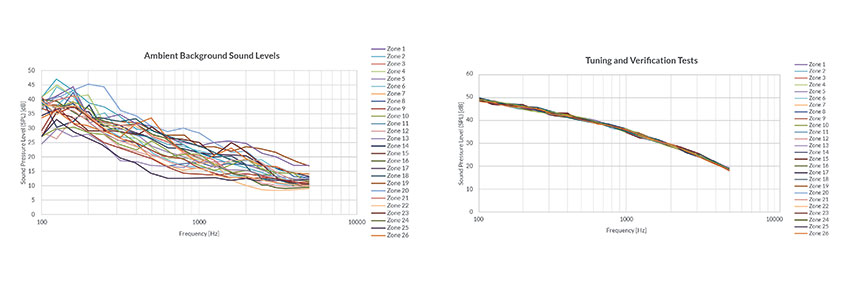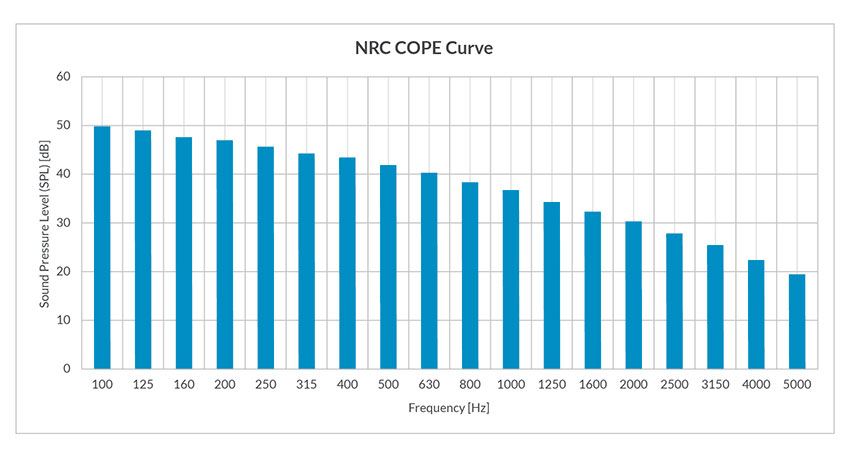Rethinking Acoustics
Context
A person’s assessment of sound generally depends on personal preferences and expectations for the occupied environment as well as the activity in which they are engaged. For instance, consider a conversation at “normal level” in two environments: a library and a busy restaurant. In the former, nearby occupants engrossed in a task requiring concentration are likely to find the conversation too loud, annoying, and disruptive. In the latter, the level of conversation may not be sufficiently loud to allow for clear communication. Expectations are based on an understanding of the purpose of the space and the task at hand.
Content
One’s description of sound tends to focus on two main properties: its level (often referred to as volume) and its spectral distribution. A “hissy” or “screechy” sound is one that has a lot of high frequency information (e.g., a young child screaming). A “bassy” or “rumbly” sound is one with a lot of low frequency information (e.g., a lion roaring). A space without a balanced sound spectrum can sound worse than one with a higher sound level, but with a balanced spectrum.
Cover
The human experience is also determined by the space’s background sound level, which is considered to be the collection of all (ambient) sounds within it. Often, a room is too “silent” (i.e., its ambient level is too low) and a source of sound becomes uncomfortable (e.g., a clock ticking, cars driving by, people talking, lights humming). In these cases, the “signal” is disturbing because its level is higher than the background sound. The disruptive impact of these annoying noises can be lessened by reducing the signal-to-noise ratio, which is achieved by raising the background sound level. In some cases, it is possible to raise the background sound level sufficiently to completely cover up these unwanted sounds.
The Need For Control
Given both the scientific and human factors, one can readily see there are advantages to controlling background sound, rather than accepting large variations in its level and spectra.
The consequences of neglecting this principal parameter of architectural acoustical design is an environment that is perceived to be “noisy,” as presented in Figure 1 (next page). The alternative—to add sound to reduce the perception of a noisy environment—might seem counterintuitive, but consider Figure 2. By precisely controlling the spectrum and level of sound (in this case, to a target overall sound pressure level of 47 dBA), one can make the space sound more comfortable.
The difference between one’s experience in a space with a very low ambient level and one with a higher ambient level suggests just as there is a need to differentiate between “sound” and “noise,” there is value in distinguishing between a “silent” space and a “quiet” one. Whereas “silent” infers the absence of sound, a “quiet” space can be characterized by a constant ambient sound that is comfortable and not readily noticeable by its occupants. Spaces such as these are perceived to be less “noisy” and more comfortable—or “quiet.”

Photo courtesy of KR Moeller Associates Ltd.
Figure 1 (left): Many people assume that the acoustic conditions are uniform throughout a facility, but without the use of a properly designed and commissioned sound masking system, it is never the case. In this example of an unmasked space—one floor, primarily consisting of open plan—the “natural” background levels of the unoccupied space vary considerably between the 26 zones in which ambient measurements were taken. Figure 2 (right): These inconsistencies can be addressed using a sound masking system—the only acoustical treatment that can accurately control the background sound level within a facility. Here, you can see the difference when masking sound is applied and tuned so that it consistently meets the NRC curve within each zone to ensure uniformity of acoustic conditions throughout the space. The acoustically consistent environment is more comfortable—or “quiet”—for occupants.
Evolution Of Sound Masking
Advanced technologies—called sound masking systems—have been developed to control the level and properties of ambient sound within commercial spaces. These systems consist of a series of loudspeakers installed in a grid-like pattern in an open ceiling or above the ceiling treatment. The loudspeakers’ output is controlled using additional equipment. The first instances of their installation followed publication of Cavanaugh’s influential Speech Privacy in Buildings book. However, at the time, there were several obstacles to their adoption as an effective acoustical design strategy.
First, these early systems were widely considered failures due to technological limitations and a lack of understanding and application of acoustical theory, which affected both their design and commissioning (e.g., large zones, limited control over volume and frequency settings). Ultimately, they failed to deliver a consistent, comfortable sound.
Second, their deployment coincided with sudden awareness and aggressive regulation of “noise exposure.” Although earlier efforts were made in other countries, the most comprehensive attempt to combat noise nuisance came in the form of the United States of America’s Noise Control Act of 1972. Many other governments and organizations have since used this document as the basis for their own regulations regarding occupational health and safety, environmental noise, transportation noise, and built environments (e.g., HVAC, building services), the primary focus of which is to limit sudden or prolonged exposure to high “noise” levels that would cause hearing loss.1
However, research shows the definition of “noise” should also include “unwanted sound” (e.g., that which interferes with one’s ability to concentrate on the task at hand or get a good night’s rest). These noises do not meet the same criteria as those damaging physical structures, but their impact is nonetheless undesirable. Background sound can have a positive and mitigating effect here and, hence, the need to make the distinction. Rather than trying to create a silent, library-like space in which there is little to no sound at all (i.e., a “silent” space), the goal is to create a “quiet” space—one in which there is little to no unwanted sound.
Last, developing the masking spectrum was an iterative process spanning several decades. With the development of methodology to assess the acoustical privacy of spaces—namely, the articulation index (AI)—discussion turned toward specification of reasonable targets for acoustical privacy and renewed interest in determining what type of background sound would work best and how it could be delivered. After all, if the intention is to improve privacy, one not only needs to control the level of background sound but also ensure the sound has specific qualities. In the 2000s, the National Research Council (NRC) refined the spectrum, based on tests measuring both comfort and effectiveness, resulting in the cost-effective open-plan environment (COPE) masking spectrum (Figure 3, next page).
It is important to note delivery of effective “masking” is not a product of the sound generating and control equipment (i.e., the electrical signal), but rather the ability of the sound masking system to adapt the generated sound that is actually delivered to the space and which is dependent on the space’s architecture—its layout, furnishings, and finishings. To achieve the desired effect, the sound produced within the space must be adjusted to a specific spectrum through a post-installation process called tuning.
Ensuring effective performance also requires verification. ASTM E1573-18, Standard Test Method for Evaluating Masking Sound in Open Offices Using A-Weighted and One-Third Octave Band Sound Pressure Levels, offers guidance and instruction on the measurement procedure to evaluate the performance of a commissioned masking system. Measurements are performed in every 93 square meters (1,000 square feet) of open space and a representative number of closed rooms to review effectiveness of the tuning process against performance targets and tolerances, and to provide an indication of the spatial uniformity of the masking sound.
In the last decade or so, great advancements have been made with regard to masking technology’s ability to accurately and consistently achieve a comfortable and effective masking sound across treated spaces. When designed with small zones no larger than 21 to 63 square meters (225 to 625 square feet) offering fine volume (i.e., 0.5 dBA) and frequency (i.e., 1/3 octave) control, a networked-decentralized architecture can provide consistency in the overall masking volume not exceeding ±0.5 dBA, as well as highly consistent masking spectrums, yielding much better tuning results than possible with previous architectures. Some systems can also be automatically tuned using software, which first measures the sound within a zone and then rapidly adjusts the volume and frequency settings to achieve the specified curve.

Photo courtesy of KR Moeller Associates Ltd.
The National Research Council (NRC) Cost-Effective Open-Plan Environment (COPE) masking spectrum. The slope is approximated by 4.90 dB/oct. between 125 and 5,000 Hz. While the low frequencies do not contribute as greatly to speech privacy as the frequencies in the middle to high range, they are necessary for comfort. Without those, occupants would perceive the sound as “hissy.”









